In 1776 Two brothers, John and James, from Northern Ireland began to produce a whisky celebrated for its exceptional smoothness and taste: J. & J. McConnell. McConnell’s quickly became the toast of Belfast,was shipped to all corners of the globe, helping to establish Irish whisky as the most popular drink in the world. The McConnell’s distillery was right on the banks of River Lagan, a sprawling, buzzing compound dedicated to one pursuit: producing the finest whisky in all of Ireland.
Then on one fateful day in 1909, 500,000 gallons of McConnell’s whisky went up in flames and by the time it was over, half the distillery lay in ruins.This would have been the end for most whiskies. But not McConnell’s. They began to rebuild. Before long, they were back on top of the Irish whisky world.
But then calamity struck again. This time it wasn’t a fire – it was Prohibition, which outlawed the sale of liquor in the United States.America was the biggest market for Irish whisky, and suddenly it was gone. Ninety percent of Irish whiskies went under as a result of Prohibition, including McConnell’s.
-
Out of stock

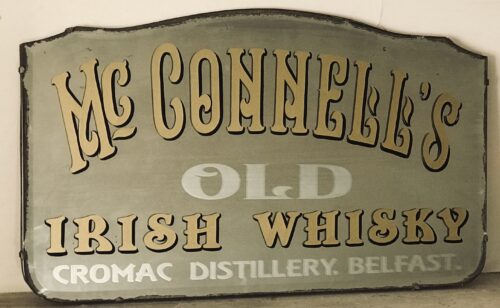 Fantastic McConnell's Old Irish Whiskey Mirror (Cromac Distillery Belfast)-McConnell's closed in 1930 so we estimate this mirror to be approximately 95-110 years old.Please email us for further details and pricing. 40cm x 70cm Portadown Co Armagh (Please note that all of our rare, expensive mirrors are packed,protected and secured with the utmost care and are shipped via DHL in specially constructed plywood transport containers )
Fantastic McConnell's Old Irish Whiskey Mirror (Cromac Distillery Belfast)-McConnell's closed in 1930 so we estimate this mirror to be approximately 95-110 years old.Please email us for further details and pricing. 40cm x 70cm Portadown Co Armagh (Please note that all of our rare, expensive mirrors are packed,protected and secured with the utmost care and are shipped via DHL in specially constructed plywood transport containers ) -
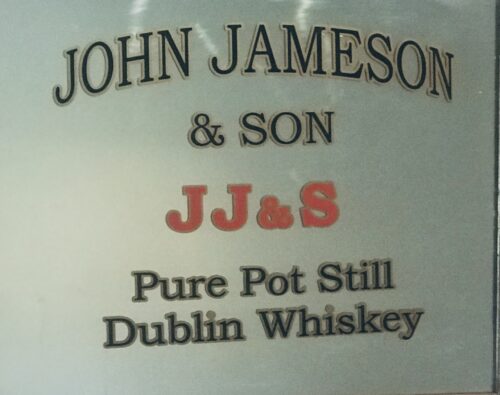
 Absolutely magnificent John Jameson & Son Pure Pot Still Whiskey Mirror originating from the 1930s.In excellent condition save for some age related damage to the original frame.This standout mirror will make a showpiece item for any Irish pub or the serious Jameson collector. 60cm x 75cm Stoneybatter Dublin John Jameson was originally a lawyer from Alloa in Scotland before he founded his eponymous distillery in Dublin in 1780.Prevoius to this he had made the wise move of marrying Margaret Haig (1753–1815) in 1768,one of the simple reasons being Margaret was the eldest daughter of John Haig, the famous whisky distiller in Scotland. John and Margaret had eight sons and eight daughters, a family of 16 children. Portraits of the couple by Sir Henry Raeburn are on display in the National Gallery of Ireland. John Jameson joined the Convivial Lodge No. 202, of the Dublin Freemasons on the 24th June 1774 and in 1780, Irish whiskey distillation began at Bow Street. In 1805, he was joined by his son John Jameson II who took over the family business that year and for the next 41 years, John Jameson II built up the business before handing over to his son John Jameson the 3rd in 1851. In 1901, the Company was formally incorporated as John Jameson and Son Ltd. Four of John Jameson’s sons followed his footsteps in distilling in Ireland, John Jameson II (1773 – 1851) at Bow Street, William and James Jameson at Marrowbone Lane in Dublin (where they partnered their Stein relations, calling their business Jameson and Stein, before settling on William Jameson & Co.). The fourth of Jameson's sons, Andrew, who had a small distillery at Enniscorthy, Co. Wexford, was the grandfather of Guglielmo Marconi, inventor of wireless telegraphy. Marconi’s mother was Annie Jameson, Andrew’s daughter. John Jameson’s eldest son, Robert took over his father’s legal business in Alloa. The Jamesons became the most important distilling family in Ireland, despite rivalry between the Bow Street and Marrowbone Lane distilleries. By the turn of the 19th century, it was the second largest producer in Ireland and one of the largest in the world, producing 1,000,000 gallons annually. Dublin at the time was the centre of world whiskey production. It was the second most popular spirit in the world after rum and internationally Jameson had by 1805 become the world's number one whiskey. Today, Jameson is the world's third largest single-distillery whiskey. Historical events, for a time, set the company back. The temperance movement in Ireland had an enormous impact domestically but the two key events that affected Jameson were the Irish War of Independence and subsequent trade war with the British which denied Jameson the export markets of the Commonwealth, and shortly thereafter, the introduction of prohibition in the United States. While Scottish brands could easily slip across the Canada–US border, Jameson was excluded from its biggest market for many years. The introduction of column stills by the Scottish blenders in the mid-19th-century enabled increased production that the Irish, still making labour-intensive single pot still whiskey, could not compete with. There was a legal enquiry somewhere in 1908 to deal with the trade definition of whiskey. The Scottish producers won within some jurisdictions, and blends became recognised in the law of that jurisdiction as whiskey. The Irish in general, and Jameson in particular, continued with the traditional pot still production process for many years.In 1966 John Jameson merged with Cork Distillers and John Powers to form the Irish Distillers Group. In 1976, the Dublin whiskey distilleries of Jameson in Bow Street and in John's Lane were closed following the opening of a New Midleton Distillery by Irish Distillers outside Cork. The Midleton Distillery now produces much of the Irish whiskey sold in Ireland under the Jameson, Midleton, Powers, Redbreast, Spot and Paddy labels. The new facility adjoins the Old Midleton Distillery, the original home of the Paddy label, which is now home to the Jameson Experience Visitor Centre and the Irish Whiskey Academy. The Jameson brand was acquired by the French drinks conglomerate Pernod Ricard in 1988, when it bought Irish Distillers. The old Jameson Distillery in Bow Street near Smithfield in Dublin now serves as a museum which offers tours and tastings. The distillery, which is historical in nature and no longer produces whiskey on site, went through a $12.6 million renovation that was concluded in March 2016, and is now a focal part of Ireland's strategy to raise the number of whiskey tourists, which stood at 600,000 in 2017.Bow Street also now has a fully functioning Maturation Warehouse within its walls since the 2016 renovation. It is here that Jameson 18 Bow Street is finished before being bottled at Cask Strength. In 2008, The Local, an Irish pub in Minneapolis, sold 671 cases of Jameson (22 bottles a day),making it the largest server of Jameson's in the world – a title it maintained for four consecutive years.
Absolutely magnificent John Jameson & Son Pure Pot Still Whiskey Mirror originating from the 1930s.In excellent condition save for some age related damage to the original frame.This standout mirror will make a showpiece item for any Irish pub or the serious Jameson collector. 60cm x 75cm Stoneybatter Dublin John Jameson was originally a lawyer from Alloa in Scotland before he founded his eponymous distillery in Dublin in 1780.Prevoius to this he had made the wise move of marrying Margaret Haig (1753–1815) in 1768,one of the simple reasons being Margaret was the eldest daughter of John Haig, the famous whisky distiller in Scotland. John and Margaret had eight sons and eight daughters, a family of 16 children. Portraits of the couple by Sir Henry Raeburn are on display in the National Gallery of Ireland. John Jameson joined the Convivial Lodge No. 202, of the Dublin Freemasons on the 24th June 1774 and in 1780, Irish whiskey distillation began at Bow Street. In 1805, he was joined by his son John Jameson II who took over the family business that year and for the next 41 years, John Jameson II built up the business before handing over to his son John Jameson the 3rd in 1851. In 1901, the Company was formally incorporated as John Jameson and Son Ltd. Four of John Jameson’s sons followed his footsteps in distilling in Ireland, John Jameson II (1773 – 1851) at Bow Street, William and James Jameson at Marrowbone Lane in Dublin (where they partnered their Stein relations, calling their business Jameson and Stein, before settling on William Jameson & Co.). The fourth of Jameson's sons, Andrew, who had a small distillery at Enniscorthy, Co. Wexford, was the grandfather of Guglielmo Marconi, inventor of wireless telegraphy. Marconi’s mother was Annie Jameson, Andrew’s daughter. John Jameson’s eldest son, Robert took over his father’s legal business in Alloa. The Jamesons became the most important distilling family in Ireland, despite rivalry between the Bow Street and Marrowbone Lane distilleries. By the turn of the 19th century, it was the second largest producer in Ireland and one of the largest in the world, producing 1,000,000 gallons annually. Dublin at the time was the centre of world whiskey production. It was the second most popular spirit in the world after rum and internationally Jameson had by 1805 become the world's number one whiskey. Today, Jameson is the world's third largest single-distillery whiskey. Historical events, for a time, set the company back. The temperance movement in Ireland had an enormous impact domestically but the two key events that affected Jameson were the Irish War of Independence and subsequent trade war with the British which denied Jameson the export markets of the Commonwealth, and shortly thereafter, the introduction of prohibition in the United States. While Scottish brands could easily slip across the Canada–US border, Jameson was excluded from its biggest market for many years. The introduction of column stills by the Scottish blenders in the mid-19th-century enabled increased production that the Irish, still making labour-intensive single pot still whiskey, could not compete with. There was a legal enquiry somewhere in 1908 to deal with the trade definition of whiskey. The Scottish producers won within some jurisdictions, and blends became recognised in the law of that jurisdiction as whiskey. The Irish in general, and Jameson in particular, continued with the traditional pot still production process for many years.In 1966 John Jameson merged with Cork Distillers and John Powers to form the Irish Distillers Group. In 1976, the Dublin whiskey distilleries of Jameson in Bow Street and in John's Lane were closed following the opening of a New Midleton Distillery by Irish Distillers outside Cork. The Midleton Distillery now produces much of the Irish whiskey sold in Ireland under the Jameson, Midleton, Powers, Redbreast, Spot and Paddy labels. The new facility adjoins the Old Midleton Distillery, the original home of the Paddy label, which is now home to the Jameson Experience Visitor Centre and the Irish Whiskey Academy. The Jameson brand was acquired by the French drinks conglomerate Pernod Ricard in 1988, when it bought Irish Distillers. The old Jameson Distillery in Bow Street near Smithfield in Dublin now serves as a museum which offers tours and tastings. The distillery, which is historical in nature and no longer produces whiskey on site, went through a $12.6 million renovation that was concluded in March 2016, and is now a focal part of Ireland's strategy to raise the number of whiskey tourists, which stood at 600,000 in 2017.Bow Street also now has a fully functioning Maturation Warehouse within its walls since the 2016 renovation. It is here that Jameson 18 Bow Street is finished before being bottled at Cask Strength. In 2008, The Local, an Irish pub in Minneapolis, sold 671 cases of Jameson (22 bottles a day),making it the largest server of Jameson's in the world – a title it maintained for four consecutive years. -
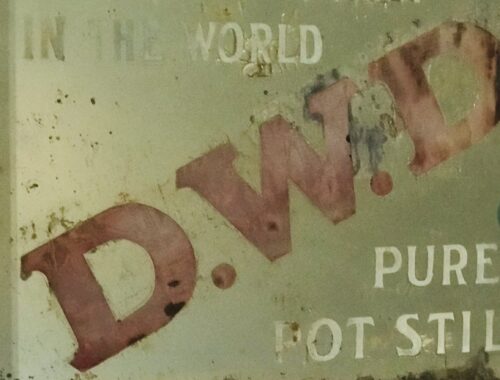
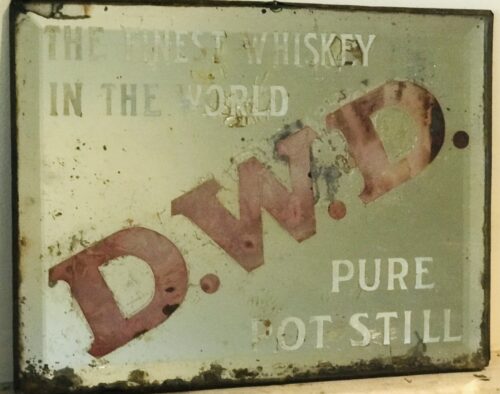 Magnificent and extremely rare small Dublin DWD Whiskey Mirror.In particular the smaller mirrors are amongst the most sought after on the market and this very special example will adorn any collection. 23cm x 30cm Rathdrum. Co Wicklow
Magnificent and extremely rare small Dublin DWD Whiskey Mirror.In particular the smaller mirrors are amongst the most sought after on the market and this very special example will adorn any collection. 23cm x 30cm Rathdrum. Co WicklowHistory of the DWD Whiskey Distillery

The Dublin Whiskey Distillery Co Rebirth & Redemption
Ireland’s history of whiskey distilling runs long and deep. The word ‘whiskey’ comes from the Gaelic, “uisce beatha”, meaning “water of life”, and Irish whiskey is one of the earliest known distilled beverages in the world, believed to have originated when Irish monks brought the technique of distilling perfumes back to Ireland around 1000 AD. Ever resourceful, the Irish modified this craft to create the wonderful spirit that endures to this day. But Irish whiskey’s most recent past reveals an extraordinary tale of subterfuge and intrigue that belies this golden spirit. The mercurial craft of whiskey making has lost none of its ethereal mystique and remains indelibly woven with what it means to be Irish. It has oiled a rich and eclectic culture that has reached far beyond our island shores. Yet the ‘light music’ appreciated by Joyce hides a dramatic tale of endurance and fortitude that has demanded so much from its leading protagonists. Neither war, nor famine or draconian law, be it home-grown or foreign made, or the shifting sands of empires and nations, or the shallow trends of libatious fashion could halt this most resolute and enduring spirit.
The founder and Master Distiller of the Dublin Whiskey Distillery Company
John Brannick, founder and master distiller of the Dublin Whiskey Distillery Company, was born into a renowned family of Irish whiskey-makers. His father Patrick and his uncles were all established distillers with Sir John Power of “Powers Irish Whiskey” fame, and in time both John and his younger brother Patrick Jr would follow in their father’s footsteps. Like all the great Irish distillers of the 19th century, the Brannick family used traditional “Pot Still” distillation, the simplest and oldest form of distillation, the principles of which have remained unchanged to this day. First, a whiskey “mash” comprised of water and grain is prepared. Yeast is added, causing fermentation, which creates alcohol in a solution known as “distiller’s beer” or “wash”. The “wash” is placed into a round bottomed copper kettle or “Pot Still” and heated to a temperature above the boiling point of alcohol but below that of water. The alcohol evaporates, leaving the water behind, and the vapour rises into a tube where it cools and condenses back into spirit. However, not all spirit is created equal. The early evaporations and the last evaporations, known as “heads” and “tails,” contain impurities, so it is the “heart” or mid part of the distillation process that the distiller seeks. The essence of distillation is timing, knowing when to “cut” between the head, heart and tail and retain only the best spirit. It was this time-honoured process that the young John Brannick learned from his father and uncles, a method to which he faithfully adhered and a skill which he perfected throughout his life. 1845 was a significant year for John Brannick when, at the age of 15, he began his formal apprenticeship at the John’s Lane Distillery. The Powers Distillery was one of the great distilleries of Dublin and young John’s experiences there instilled in him a lifelong passion for the fine art of whiskey-making. At the time, Ireland was an impoverished country with little or no industry. Distilleries constituted a rare exception and they, their owners and employees enjoyed significant status in their communities. The young John Brannick soon demonstrated a natural flair for the craft of whiskey-making. These early years, working within the hallowed halls of the John’s Lane Distillery, laid the foundations for his later exploits within the industry. It wasn’t long before the other great distilleries took note of his growing reputation and in 1852 George Roe & Sons enticed Brannick to join the House of George Roe & Co with the promise that he would some day become a Master Distiller.After nearly 20 years of perfecting his craft with the House of Roe, Brannick had reached the illustrious position of Master Distiller. His reputation amongst the great distilleries of Dublin was now firmly established, but his ambitions didn’t end there. Brannick had long harboured a burning desire to build the finest distillery in the world, and in 1870, having secured the necessary backing, he resigned his position and struck out on his own, establishing the Dublin Whiskey Distillery Company Limited. DWD.For the next two years Brannick worked on a revolutionary design for his distillery. A site was chosen, less than a mile north of Dublin’s city centre, on the banks of the River Tolka, and construction started on 22 July 1872 Exactly one year later, distillation began with the preparation of the first ever DWD wash. Meanwhile, with work on the great distillery underway, Brannick finally fulfilled another long-standing promise and married his sweetheart Mary Hayes on 26 January 1873.
The young John Brannick soon demonstrated a natural flair for the craft of whiskey-making. These early years, working within the hallowed halls of the John’s Lane Distillery, laid the foundations for his later exploits within the industry. It wasn’t long before the other great distilleries took note of his growing reputation and in 1852 George Roe & Sons enticed Brannick to join the House of George Roe & Co with the promise that he would some day become a Master Distiller.After nearly 20 years of perfecting his craft with the House of Roe, Brannick had reached the illustrious position of Master Distiller. His reputation amongst the great distilleries of Dublin was now firmly established, but his ambitions didn’t end there. Brannick had long harboured a burning desire to build the finest distillery in the world, and in 1870, having secured the necessary backing, he resigned his position and struck out on his own, establishing the Dublin Whiskey Distillery Company Limited. DWD.For the next two years Brannick worked on a revolutionary design for his distillery. A site was chosen, less than a mile north of Dublin’s city centre, on the banks of the River Tolka, and construction started on 22 July 1872 Exactly one year later, distillation began with the preparation of the first ever DWD wash. Meanwhile, with work on the great distillery underway, Brannick finally fulfilled another long-standing promise and married his sweetheart Mary Hayes on 26 January 1873.

Aeneas Coffey Inventor of the Continuous “Patent Coffee Still”
In the year in which John Brannick was born, Aeneas Coffey was granted patent #5974 for his design of a two column continuous still or “Patent Still”. The Patent Still represented a revolution in spirit distillation, eliminating the need for multi-distillation using traditional “Pot Stills” and producing a lighter spirit with a higher proof at a fraction of the cost. However, it was shunned by the great Dublin distilleries, who considered the whiskey produced to be bland and tasteless in comparison with their world-famous “Pot Still” creations. They may have also considered the arrival of the Patent Still a direct challenge to their profession, an early form of automation attempting to replace the distiller’s art and skill. Many years later John Brannick, who went on to become one of the great masters of Pot Still whiskey, would reflect on the irony that the year of his birth marked the establishment of the Patent Still, the nemesis of his life’s work
The DWD Legacy is Reborn
Two old friends meet amid the bustle of the city and retire to the Palace Bar on Fleet Street to remember old times. By chance, one of them notices a bottle – a very old, unopened whiskey bottle with a mysterious, faded label – sitting in a glass case behind the bar. A relic of lost times. ‘What is that?’ he asks the barman. With this simple question, not one but two journeys began: a journey back in time into the extraordinary story of the “Finest Whiskey in the World”, a story of one man’s vision, gloriously realised, crushed by history and destroyed in a very Irish betrayal. And a journey into the future, the future of a once-great distillery, dismantled, neglected and forgotten. Until now. After 75 long years, DWD is back. Today’s DWD is not a copy of the past: a simple reproduction for nostalgia’s sake. Since the distillery closed its doors in 1941 the world has moved on and advances in the art of distilling cannot be ignored. But some values are timeless and remain as cherished and respected as they did when John Brannick laid the cornerstone of his great distillery in theglorious summer of 1872: real character, brave resolve and a true sense of belonging. Today’s DWD is the natural heir of its noble ancestor, a modern whiskey that draws on the wisdom of the past. And this is only the beginning of the DWD revival. In time, Brannick’s great house will be rebuilt, his achievements rivalled and perhaps even surpassed. But for now let us raise a glass to the return of the “Finest Whiskey in the World”, and look forward to the glories yet to come.
The Finest Whiskey in The World
Today, Irish whiskey is regulated and controlled both by international law and the Irish Whiskey Association. The definition of Irish whiskey and the method of production is globally agreed and enforced to ensure industry standards are protected and maintained at all times. However, back in 1880 no such legal definitions existed, and the global success of the industry began to attract the attention of disreputable characters intent on passing off various spirits and concoctions as ‘Irish whiskey’. The problem was made worse by the great distilleries of Dublin, which were content to leave bottling and branding to merchants and bonders. This laissez-faire attitude enabled unscrupulous dealers to import cheap Scotch and pass it off as highly desirable Irish whiskey. True to form, John Brannick was one of the first to recognise the danger and take steps to protect both his whiskey and his customers from counterfeit products. In 1880 he introduced the famous DWD Post Still logo to identify and market the DWD brand. He controlled its use tightly, working only with trusted merchants and bonders to ensure the DWD brand was respected and admired as the “Finest Whiskey in the World”.“The extraordinary story of the ‘Finest Whiskey in the World’, a tale of one man’s vision, gloriously realised, only to be crushed by history and destroyed in a very Irish betrayal.” Tomas – DWD Brand Ambassador
THE GREATEST ACCOLADE
In 1887 Brannick’s achievements and DWD’s greatness were formally recognized by two seminal publications: The Whisky Distilleries of the United Kingdom by Alfred Barnard and The Industries of Dublin by Spencer Blackett. Barnard’s work has been described as the most important book ever written on whiskey. It was Barnard who first recognised DWD as one of the six “Great Distilleries of Dublin City” by inspecting the distillery in the summer of 1886. Barnard described DWD as “the most modern of the distilleries in Dublin, handsomely designed and of great ornamentation, it rears its head proud and at a distance looks like a monument built to commemorate the virtues of some dead hero.” Barnard also acknowledged “that a mastermind and skilled hand had planned this great work.”The Six Great Distilleries Of Dublin City
During the 19th and early 20th centuries, Irish whiskey was the most prestigious whiskey industry in the world. At the heart of this industry stood Dublin, its whiskey recognised the world over as the finest expression of the art and now, with the acclaim of Alfred Barnard and other connoisseurs, DWD assumed its rightful place among the “Great Distilleries of Dublin City”, an exclusive club that brought together the six great masters of Irish whiskey: John Jameson & Co, William Jameson & Co, Sir John Power & Sons, George Roe & Sons, The Phoenix Park Distillery and, of course, the Dublin Whiskey Distillery. -
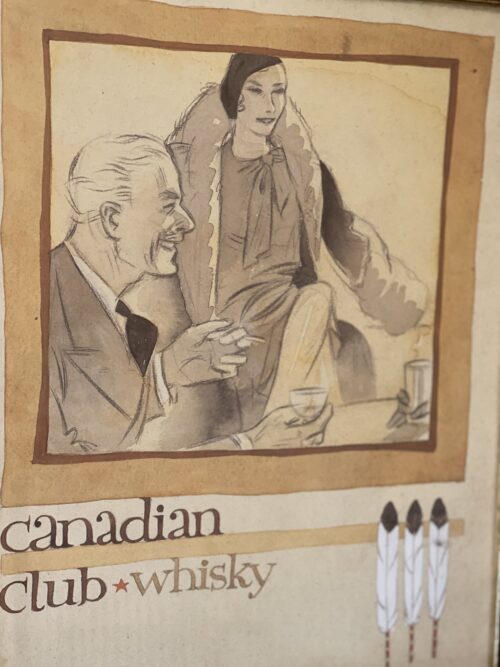
 Killarney Co Kerry (via Ontario) 34cm x 26cm Canadian Club is a brand of Canadian whisky produced by Beam Suntory. Popularly known as CC, Canadian Club was created by Hiram Walker and Sons, an evolution of a brand around a product that took place over the second half of the nineteenth century. Hiram Walker merged with Gooderham & Worts, Ltd. in 1926, yielding Hiram Walker-Gooderham & Worts, Ltd.
Killarney Co Kerry (via Ontario) 34cm x 26cm Canadian Club is a brand of Canadian whisky produced by Beam Suntory. Popularly known as CC, Canadian Club was created by Hiram Walker and Sons, an evolution of a brand around a product that took place over the second half of the nineteenth century. Hiram Walker merged with Gooderham & Worts, Ltd. in 1926, yielding Hiram Walker-Gooderham & Worts, Ltd.History
Hiram Walker founded his distillery in 1858 in Detroit. He first learned how to distill cider vinegar in his grocery store in the 1830s before moving on to whisky and producing his first barrels in 1854. However, with the Prohibition movement gathering momentum and Michigan already becoming "dry," Walker decided to move his distillery across the Detroit Riverto Windsor, Ontario. From here, he was able to export his whisky and start to develop Walkerville, a model community that Walker financed to provide housing and services for his employees. Walker's whisky was particularly popular in the late 19th century gentlemen's clubs of the United States and Canada; hence it became known as "Club Whisky." Walker originally positioned the whisky as a premium liquor, pitching it not only on its smoothness and purity but also its five-year oak barrel aging. Club Whisky became very popular and American distillers petitioned for the inclusion of the word "Canada" on the bottle to distinguish it from their competing whiskies, thinking it would hamper the popularity of Walker's.This backfired, only making Club Whisky more exclusive. Walker saw this and changed the label again in 1889 adding the word "Canadian" to the top of the label, distinguishing Walker's recipe for his whisky from the other processes of the time. In 1890, the word "Canadian" was moved down from the top of the label and incorporated into the name of the whisky. Walker's distillery passed to his sons upon his death in 1899. At one point, the Walkers employed almost the entire population of Walkerville, where they built police and fire stations, brought in running water and installed street lights. In 1890, the Canadian government acknowledged Walkerville as a legal town. It was incorporated into Windsor in 1935. During the years of Prohibition, one of the distillery's most important clients was Chicago gangster Al Capone, who smuggled in thousands of cases of Canadian Club via a route from Windsor to Detroit. Canadian Club has received the royal warrants of Queen Victoria, Edward VII, George V, George VI, and Elizabeth II. Hiram Walker & Sons is the only North American distiller to have been granted a royal warrant. The Walker distillery remains in production in Windsor. Canadian Club is now part of the Jim Beam portfolio. It is its number four–selling alcoholic product, behind Jim Beam bourbon whiskey, Sauza Tequila, and DeKuyper cordials.Advertising
In 1967, Hiram Walker & Sons launched their "Hide A Case" advertising campaign that enticed drinkers to seek out cases of Canadian Club hidden at exotic locations throughout the world, including Mount Kilimanjaro, Angel Falls, Mount St. Helens and the Swiss Alps. The Mount Kilimanjaro case was not discovered until a Dutch journalist happened upon it in the mid-1970s. A small number of cases, such as one hidden above the Arctic Circle, were never found. The first "Hide A Case" campaign officially ended in 1971. A second was started in 1975, where cases were hidden in places intended to be easier to access, such as in Death Valley and on top of a skyscraper in New York City. This second campaign ended in 1981; between it and the first, 22 cases were hidden and at least 16 recovered. A print ad for the drink would serve as inspiration for the pre-title sequence of the 1977 Bond movie, The Spy Who Loved Me (film). In the 2007 IndyCar Series season, they were main the sponsor for Andretti Green Racing #27 driver, Dario Franchitti during their championship winning season, which also included winning the 2007 Indianapolis 500. The "Hide A Case" campaign was revived in 2010. According to the contest website, there is a $100,000 grand prize, among other prizes, for the contest's latest incarnation. Canadian Club was a frequent product placement in the AMC show Mad Men, often being the drink of choice for the main character Don Draper. -
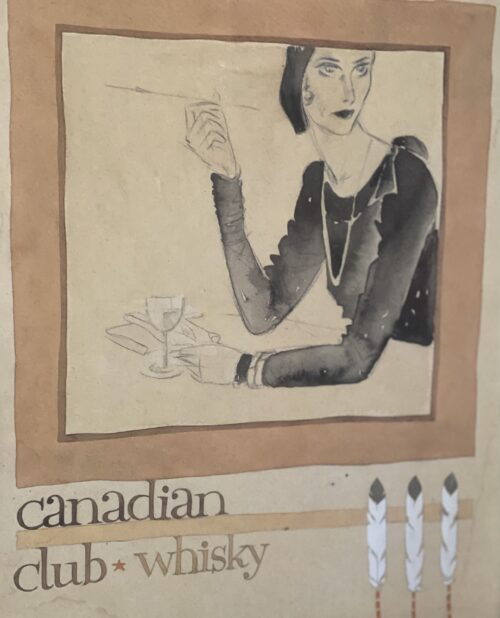
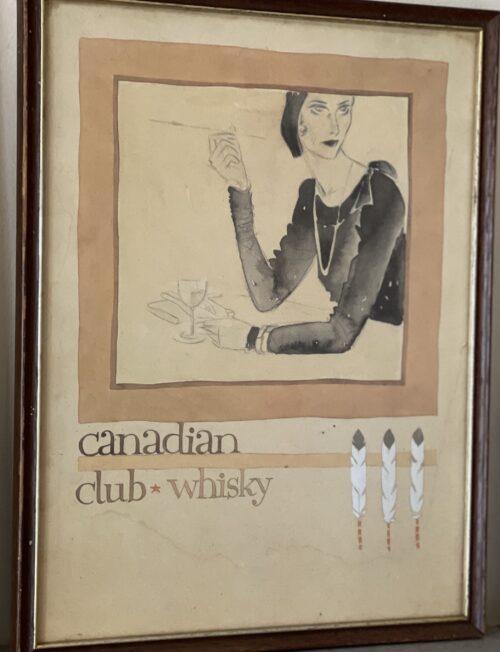 Killarney Co Kerry (via Ontario) 34cm x 26cm Canadian Club is a brand of Canadian whisky produced by Beam Suntory. Popularly known as CC, Canadian Club was created by Hiram Walker and Sons, an evolution of a brand around a product that took place over the second half of the nineteenth century. Hiram Walker merged with Gooderham & Worts, Ltd. in 1926, yielding Hiram Walker-Gooderham & Worts, Ltd.
Killarney Co Kerry (via Ontario) 34cm x 26cm Canadian Club is a brand of Canadian whisky produced by Beam Suntory. Popularly known as CC, Canadian Club was created by Hiram Walker and Sons, an evolution of a brand around a product that took place over the second half of the nineteenth century. Hiram Walker merged with Gooderham & Worts, Ltd. in 1926, yielding Hiram Walker-Gooderham & Worts, Ltd.History
Hiram Walker founded his distillery in 1858 in Detroit. He first learned how to distill cider vinegar in his grocery store in the 1830s before moving on to whisky and producing his first barrels in 1854. However, with the Prohibition movement gathering momentum and Michigan already becoming "dry," Walker decided to move his distillery across the Detroit Riverto Windsor, Ontario. From here, he was able to export his whisky and start to develop Walkerville, a model community that Walker financed to provide housing and services for his employees. Walker's whisky was particularly popular in the late 19th century gentlemen's clubs of the United States and Canada; hence it became known as "Club Whisky." Walker originally positioned the whisky as a premium liquor, pitching it not only on its smoothness and purity but also its five-year oak barrel aging. Club Whisky became very popular and American distillers petitioned for the inclusion of the word "Canada" on the bottle to distinguish it from their competing whiskies, thinking it would hamper the popularity of Walker's.This backfired, only making Club Whisky more exclusive. Walker saw this and changed the label again in 1889 adding the word "Canadian" to the top of the label, distinguishing Walker's recipe for his whisky from the other processes of the time. In 1890, the word "Canadian" was moved down from the top of the label and incorporated into the name of the whisky. Walker's distillery passed to his sons upon his death in 1899. At one point, the Walkers employed almost the entire population of Walkerville, where they built police and fire stations, brought in running water and installed street lights. In 1890, the Canadian government acknowledged Walkerville as a legal town. It was incorporated into Windsor in 1935. During the years of Prohibition, one of the distillery's most important clients was Chicago gangster Al Capone, who smuggled in thousands of cases of Canadian Club via a route from Windsor to Detroit. Canadian Club has received the royal warrants of Queen Victoria, Edward VII, George V, George VI, and Elizabeth II. Hiram Walker & Sons is the only North American distiller to have been granted a royal warrant. The Walker distillery remains in production in Windsor. Canadian Club is now part of the Jim Beam portfolio. It is its number four–selling alcoholic product, behind Jim Beam bourbon whiskey, Sauza Tequila, and DeKuyper cordials.Advertising
In 1967, Hiram Walker & Sons launched their "Hide A Case" advertising campaign that enticed drinkers to seek out cases of Canadian Club hidden at exotic locations throughout the world, including Mount Kilimanjaro, Angel Falls, Mount St. Helens and the Swiss Alps. The Mount Kilimanjaro case was not discovered until a Dutch journalist happened upon it in the mid-1970s. A small number of cases, such as one hidden above the Arctic Circle, were never found. The first "Hide A Case" campaign officially ended in 1971. A second was started in 1975, where cases were hidden in places intended to be easier to access, such as in Death Valley and on top of a skyscraper in New York City. This second campaign ended in 1981; between it and the first, 22 cases were hidden and at least 16 recovered. A print ad for the drink would serve as inspiration for the pre-title sequence of the 1977 Bond movie, The Spy Who Loved Me (film). In the 2007 IndyCar Series season, they were main the sponsor for Andretti Green Racing #27 driver, Dario Franchitti during their championship winning season, which also included winning the 2007 Indianapolis 500. The "Hide A Case" campaign was revived in 2010. According to the contest website, there is a $100,000 grand prize, among other prizes, for the contest's latest incarnation. Canadian Club was a frequent product placement in the AMC show Mad Men, often being the drink of choice for the main character Don Draper. -
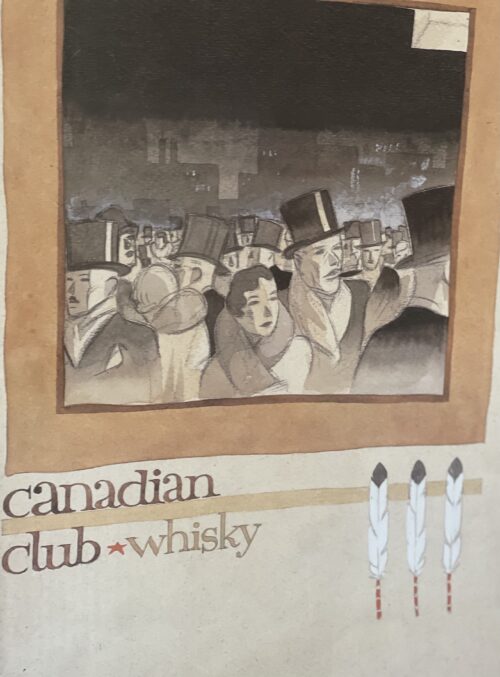
 Killarney Co Kerry (via Ontario) 34cm x 26cm Canadian Club is a brand of Canadian whisky produced by Beam Suntory. Popularly known as CC, Canadian Club was created by Hiram Walker and Sons, an evolution of a brand around a product that took place over the second half of the nineteenth century. Hiram Walker merged with Gooderham & Worts, Ltd. in 1926, yielding Hiram Walker-Gooderham & Worts, Ltd.
Killarney Co Kerry (via Ontario) 34cm x 26cm Canadian Club is a brand of Canadian whisky produced by Beam Suntory. Popularly known as CC, Canadian Club was created by Hiram Walker and Sons, an evolution of a brand around a product that took place over the second half of the nineteenth century. Hiram Walker merged with Gooderham & Worts, Ltd. in 1926, yielding Hiram Walker-Gooderham & Worts, Ltd.History
Hiram Walker founded his distillery in 1858 in Detroit. He first learned how to distill cider vinegar in his grocery store in the 1830s before moving on to whisky and producing his first barrels in 1854. However, with the Prohibition movement gathering momentum and Michigan already becoming "dry," Walker decided to move his distillery across the Detroit Riverto Windsor, Ontario. From here, he was able to export his whisky and start to develop Walkerville, a model community that Walker financed to provide housing and services for his employees. Walker's whisky was particularly popular in the late 19th century gentlemen's clubs of the United States and Canada; hence it became known as "Club Whisky." Walker originally positioned the whisky as a premium liquor, pitching it not only on its smoothness and purity but also its five-year oak barrel aging. Club Whisky became very popular and American distillers petitioned for the inclusion of the word "Canada" on the bottle to distinguish it from their competing whiskies, thinking it would hamper the popularity of Walker's.This backfired, only making Club Whisky more exclusive. Walker saw this and changed the label again in 1889 adding the word "Canadian" to the top of the label, distinguishing Walker's recipe for his whisky from the other processes of the time. In 1890, the word "Canadian" was moved down from the top of the label and incorporated into the name of the whisky. Walker's distillery passed to his sons upon his death in 1899. At one point, the Walkers employed almost the entire population of Walkerville, where they built police and fire stations, brought in running water and installed street lights. In 1890, the Canadian government acknowledged Walkerville as a legal town. It was incorporated into Windsor in 1935. During the years of Prohibition, one of the distillery's most important clients was Chicago gangster Al Capone, who smuggled in thousands of cases of Canadian Club via a route from Windsor to Detroit. Canadian Club has received the royal warrants of Queen Victoria, Edward VII, George V, George VI, and Elizabeth II. Hiram Walker & Sons is the only North American distiller to have been granted a royal warrant. The Walker distillery remains in production in Windsor. Canadian Club is now part of the Jim Beam portfolio. It is its number four–selling alcoholic product, behind Jim Beam bourbon whiskey, Sauza Tequila, and DeKuyper cordials.Advertising
In 1967, Hiram Walker & Sons launched their "Hide A Case" advertising campaign that enticed drinkers to seek out cases of Canadian Club hidden at exotic locations throughout the world, including Mount Kilimanjaro, Angel Falls, Mount St. Helens and the Swiss Alps. The Mount Kilimanjaro case was not discovered until a Dutch journalist happened upon it in the mid-1970s. A small number of cases, such as one hidden above the Arctic Circle, were never found. The first "Hide A Case" campaign officially ended in 1971. A second was started in 1975, where cases were hidden in places intended to be easier to access, such as in Death Valley and on top of a skyscraper in New York City. This second campaign ended in 1981; between it and the first, 22 cases were hidden and at least 16 recovered. A print ad for the drink would serve as inspiration for the pre-title sequence of the 1977 Bond movie, The Spy Who Loved Me (film). In the 2007 IndyCar Series season, they were main the sponsor for Andretti Green Racing #27 driver, Dario Franchitti during their championship winning season, which also included winning the 2007 Indianapolis 500. The "Hide A Case" campaign was revived in 2010. According to the contest website, there is a $100,000 grand prize, among other prizes, for the contest's latest incarnation. Canadian Club was a frequent product placement in the AMC show Mad Men, often being the drink of choice for the main character Don Draper. -
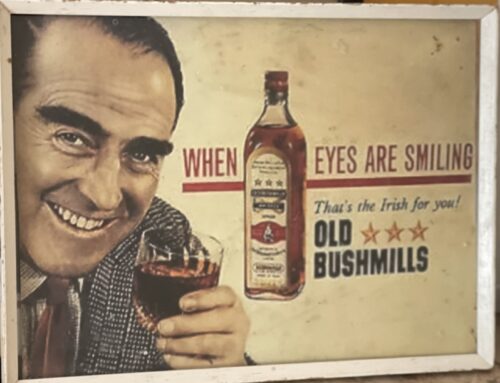
 32cm x 24cm Bushmills is officially the worlds oldest whiskey distillery- when in 1608 King James I granted Sir Thomas Phillips,landowner and Governor of Co Antrim,Ireland - a licence to distill.It was in 1784 when Mr Hugh Anderson registered the Old Bushmills Distillery and the Pot Still became its registered trademark, which is still a mark of genuine distinction to this day. The Bushmills area has a long tradition with distillation. According to one story, as far back as 1276, an early settler called Sir Robert Savage of Ards, before defeating the Irish in battle, fortified his troops with "a mighty drop of acqua vitae". In 1608, a licence was granted to Sir Thomas Phillips (Irish adventurer) by King James I to distil whiskey. The Bushmills Old Distillery Company itself was not established until 1784 by Hugh Anderson. Bushmills suffered many lean years with numerous periods of closure with no record of the distillery being in operation in the official records both in 1802 and in 1822. In 1860 a Belfast spirit merchant named Jame McColgan and Patrick Corrigan bought the distillery; in 1880 they formed a limited company. In 1885, the original Bushmills buildings were destroyed by fire but the distillery was swiftly rebuilt. In 1890, a steamship owned and operated by the distillery, SS Bushmills, made its maiden voyage across the Atlantic to deliver Bushmills whiskey to America. It called at Philadelphiaand New York City before heading on to Singapore, Hong Kong, Shanghai and Yokohama.In the early 20th century, the U.S. was a very important market for Bushmills (and other Irish Whiskey producers). American Prohibition in 1920 came as a large blow to the Irish Whiskey industry, but Bushmills managed to survive. Wilson Boyd, Bushmills' director at the time, predicted the end of prohibition and had large stores of whiskey ready to export. After the Second World War, the distillery was bought by Isaac Wolfson, and, in 1972, it was taken over by Irish Distillers, meaning that Irish Distillers controlled the production of all Irish whiskey at the time. In June 1988, Irish Distillers was bought by French liquor group Pernod Ricard.In June 2005, the distillery was bought by Diageo for £200 million. Diageo have also announced a large advertising campaign in order to regain a market share for Bushmills.In May 2008, the Bank of Ireland issued a new series of sterling banknotes in Northern Ireland which all feature an illustration of the Old Bushmills Distillery on the obverse side, replacing the previous notes series which depicted Queen's University of Belfast. In November 2014 it was announced that Diageo had traded the Bushmills brand with Jose Cuervo in exchange for the 50% of the Don Julio brand of tequila that Diageo did not already own.
32cm x 24cm Bushmills is officially the worlds oldest whiskey distillery- when in 1608 King James I granted Sir Thomas Phillips,landowner and Governor of Co Antrim,Ireland - a licence to distill.It was in 1784 when Mr Hugh Anderson registered the Old Bushmills Distillery and the Pot Still became its registered trademark, which is still a mark of genuine distinction to this day. The Bushmills area has a long tradition with distillation. According to one story, as far back as 1276, an early settler called Sir Robert Savage of Ards, before defeating the Irish in battle, fortified his troops with "a mighty drop of acqua vitae". In 1608, a licence was granted to Sir Thomas Phillips (Irish adventurer) by King James I to distil whiskey. The Bushmills Old Distillery Company itself was not established until 1784 by Hugh Anderson. Bushmills suffered many lean years with numerous periods of closure with no record of the distillery being in operation in the official records both in 1802 and in 1822. In 1860 a Belfast spirit merchant named Jame McColgan and Patrick Corrigan bought the distillery; in 1880 they formed a limited company. In 1885, the original Bushmills buildings were destroyed by fire but the distillery was swiftly rebuilt. In 1890, a steamship owned and operated by the distillery, SS Bushmills, made its maiden voyage across the Atlantic to deliver Bushmills whiskey to America. It called at Philadelphiaand New York City before heading on to Singapore, Hong Kong, Shanghai and Yokohama.In the early 20th century, the U.S. was a very important market for Bushmills (and other Irish Whiskey producers). American Prohibition in 1920 came as a large blow to the Irish Whiskey industry, but Bushmills managed to survive. Wilson Boyd, Bushmills' director at the time, predicted the end of prohibition and had large stores of whiskey ready to export. After the Second World War, the distillery was bought by Isaac Wolfson, and, in 1972, it was taken over by Irish Distillers, meaning that Irish Distillers controlled the production of all Irish whiskey at the time. In June 1988, Irish Distillers was bought by French liquor group Pernod Ricard.In June 2005, the distillery was bought by Diageo for £200 million. Diageo have also announced a large advertising campaign in order to regain a market share for Bushmills.In May 2008, the Bank of Ireland issued a new series of sterling banknotes in Northern Ireland which all feature an illustration of the Old Bushmills Distillery on the obverse side, replacing the previous notes series which depicted Queen's University of Belfast. In November 2014 it was announced that Diageo had traded the Bushmills brand with Jose Cuervo in exchange for the 50% of the Don Julio brand of tequila that Diageo did not already own.- Bushmills Original – Irish whiskey blend sometimes called White Bush or Bushmills White Label. The grain whiskey is matured in American oak casks.
- Black Bush – A blend with a significantly greater proportion of malt whiskey than the white label. It features malt whiskey aged in casks previously used for Spanish Oloroso sherry.
- Red Bush – Like the Black Bush, this is a blend with a higher proportion of malt whiskey than the standard bottling, but in contrast the malt whiskey has been matured in ex-bourbon casks.
- Bushmills 10 year single malt – Combines malt whiskeys aged at least 10 years in American bourbon or Oloroso sherry casks.
- Bushmills Distillery Reserve 12 year single malt – exclusively available at the Old Bushmills Distillery, this 12 year aged single malt is matured in oak casks for a rich, complex flavour with notes of sherry, dark chocolate and spices.
- Bushmills 16 year single malt – Malt whiskeys aged at least 16 years in American bourbon barrels or Spanish Oloroso sherry butts are mixed together before finishing in Port pipes for a few months.
- Bushmills 21 year single malt – A limited number of 21 year bottles are made each year. After 19 years, bourbon-barrel-aged and sherry-cask-aged malt whiskeys are combined, which is followed by two years of finishing in Madeira drums.
- Bushmills 1608: Originally released as a special 400th Anniversary whiskey; since 2009 it will be available only in the Whiskey Shop at the distillery and at duty-free shops.
-
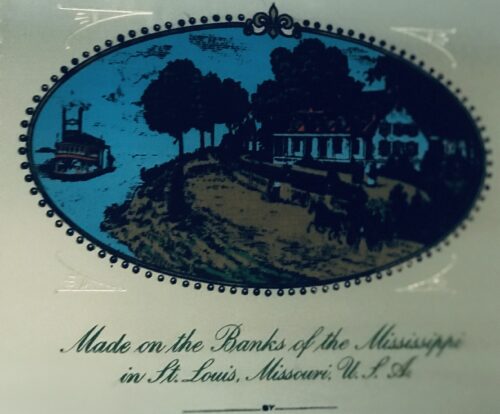
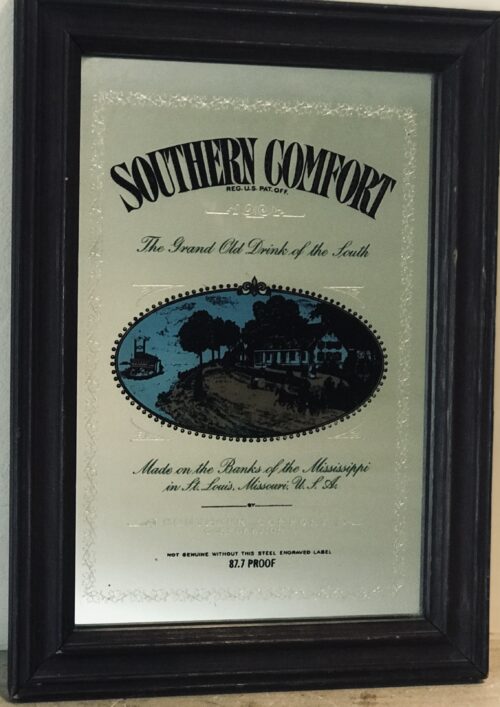 35cm x 25cm Southern Comfort (often abbreviated SoCo) is an American fruit-flavored liqueur with fruit and spice accents.The brand was originally created by bartender Martin Wilkes Heron in New Orleans in 1874, and originally used whiskey as the base spirit. Since March 1, 2016, the brand has been owned by the Sazerac Company, which purchased it from Brown–Forman.
35cm x 25cm Southern Comfort (often abbreviated SoCo) is an American fruit-flavored liqueur with fruit and spice accents.The brand was originally created by bartender Martin Wilkes Heron in New Orleans in 1874, and originally used whiskey as the base spirit. Since March 1, 2016, the brand has been owned by the Sazerac Company, which purchased it from Brown–Forman.History
Southern Comfort was first produced by bartender Martin Wilkes Heron (1850–1920), the son of a boat-builder, in 1874 at McCauley's Tavern in the Lower Garden District, two miles north of the French Quarter of New Orleans, Louisiana.According to the New Orleans Convention & Visitors Bureau, McCauley's Tavern was "just off Bourbon Street", and the original form of the drink was called Cuffs and Buttons. Heron moved to Memphis, Tennessee in 1889, patented his creation, and began selling it in sealed bottles with the slogan "None Genuine But Mine" and "Two per customer. No Gentleman would ask for more." Southern Comfort won the gold medal at the 1904 World's Fair in St. Louis, Missouri. In an episode of The Thirsty Traveler entitled "A River of Whiskey", spirits historian Chris Morris describes the original recipe of Southern Comfort. Heron began with good-quality bourbon and would add: A pre-2010 Southern Comfort bottle with its label showing an illustration of Louisiana's Woodland Plantation. The label was redesigned in 2010.
A pre-2010 Southern Comfort bottle with its label showing an illustration of Louisiana's Woodland Plantation. The label was redesigned in 2010.An inch of vanilla bean, about a quarter of a lemon, half of a cinnamon stick, four cloves, a few cherries, and an orange bit or two. He would let this soak for days. And right when he was ready to finish, he would add his sweetener: he liked to use honey.
The original brand closed during Prohibition and was reopened afterward by Francis Fowler. Between the 1930s and 2010, the image on the label of Southern Comfort was A Home on the Mississippi, a rendering by Alfred Waud depicting Woodland Plantation, an antebellum mansion in West Pointe à la Hache, Louisiana, which is listed on the National Register of Historic Places, and now provides bed-and-breakfast accommodation. In 2010 the plantation artwork was dropped from the label. Brown–Forman purchased the brand in 1979. In 2011, the brand began releasing flavored variations like cherry, lime, gingerbread, and Tabasco. In January 2016 Brown–Forman sold it to Sazerac Company, along with Tuaca, as part of a $543.5 million deal. Sazerac announced that Southern Comfort's formula would be changed in 2017 to restore whiskey as the base spirit, as the original formula used. Sometime before Brown–Forman purchased the brand, it had been reformulated to use neutral spirit, with only a negligible amount of whiskey as a flavorant. Janis Joplin was known to drink Southern Comfort to excess.Varieties
In the United States, Southern Comfort is available as 42 US proof (21% ABV), 70 US proof (35% ABV), 80 US proof (40% ABV), and 100 US proof (50% ABV). Varieties including additional flavorings, such as lime and caramel, were introduced by Brown–Forman in the latter years of their ownership. These were discontinued by Sazerac.Eggnog products
Also seasonally available through various retailers is Southern Comfort-branded eggnog. These currently include two variations of eggnog flavors, Traditional and Vanilla Spice. The Traditional flavor is usually available in one quart and half gallon sizes. These eggnog products contain no alcohol. Previously, there were also ground coffees available with both of these eggnog flavorings, but the coffee products have since been discontinued.In cocktails
Southern Comfort is used in the creation of numerous cocktails, including the Alabama Slammer. One of the earliest Southern Comfort-based cocktails to be marketed was the Scarlett O'Hara, named after the character and concocted in tribute to the release of the film adaptation of Gone with the Wind in 1939. The mixture includes Southern Comfort, cranberry juice, and fresh lime. -
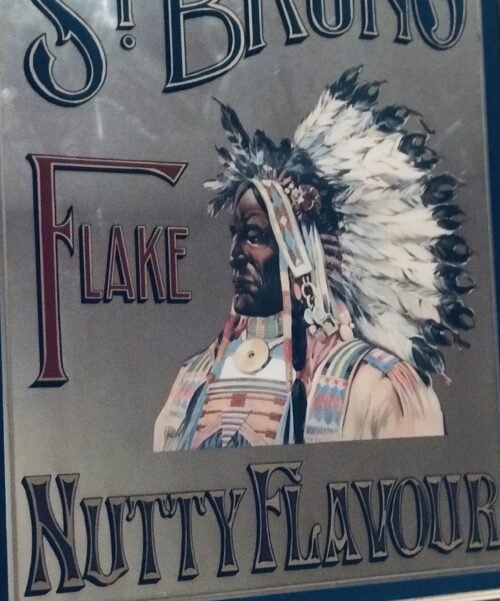
 Very distinctive 1960s Advertising mirror depicting the legendary Native American chief in ceremonial head dress and extolling its wonderful "nutty flavour". 65cm x 50cm annacotty Co Limerick St Bruno Flake is a beacon among legendary pipe tobaccos and throughout decades many pipe smokers’ true and loyal companion. A pipe tobacco born under the English Purity Law and ever since then made in the same way following the same demands for the best quality tobacco.The selected Kentucky leaf contributes with the smoky and bold character in this blend. The bright Virginia leaf makes the smoking experience smooth and pleasant.St. Bruno is a steam pressed flake tobacco known and loved by pipe smokers around the world. Origins : Co Limerick Dimensions: 65cm x 50cm 6kg
Very distinctive 1960s Advertising mirror depicting the legendary Native American chief in ceremonial head dress and extolling its wonderful "nutty flavour". 65cm x 50cm annacotty Co Limerick St Bruno Flake is a beacon among legendary pipe tobaccos and throughout decades many pipe smokers’ true and loyal companion. A pipe tobacco born under the English Purity Law and ever since then made in the same way following the same demands for the best quality tobacco.The selected Kentucky leaf contributes with the smoky and bold character in this blend. The bright Virginia leaf makes the smoking experience smooth and pleasant.St. Bruno is a steam pressed flake tobacco known and loved by pipe smokers around the world. Origins : Co Limerick Dimensions: 65cm x 50cm 6kg -

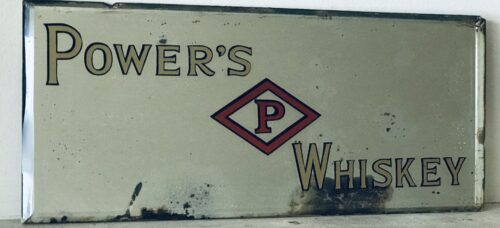 They don't come any more special than this extremely rare Power's Whiskey mirror from the 1930s.Its petite dimensions and stunning patina and considerable weight make it a real collectors item.Please email us at irishpubemporium@gmail.com for more information about this once off gem. Origins: Co Kilkenny. Dimensions:16cm x 36cm In 1791 James Power, an innkeeper from Dublin, established a small distillery at his public house at 109 Thomas St., Dublin. The distillery, which had an output of about 6,000 gallons in its first year of operation, initially traded as James Power and Son, but by 1822 had become John Power & Son,and had moved to a new premises at John’s Lane, a side street off Thomas Street. At the time the distillery had three pot stills, though only one, a 500-gallon still is thought to have been in use. Following reform of the distilling laws in 1823, the distillery expanded rapidly. In 1827, production was reported at 160,270 gallons,and by 1833 had grown to 300,000 gallons per annum. As the distillery grew, so too did the stature of the family. In 1841, John Power, grandson of the founder was awarded a baronet, a hereditary title. In 1855, his son Sir James Power, laid the foundation stone for the O’Connell Monument, and in 1859 became High Sheriff of Dublin. In 1871, the distillery was expanded and rebuilt in the Victorian style, becoming one of the most impressive sights in Dublin.After expansion, output at the distillery rose to 700,000 gallons per annum, and by the 1880s, had reached about 900,000 gallons per annum, at which point the distillery covered over six acres of central Dublin, and had a staff of about 300 people.During this period, when the Dublin whiskey distilleries were amongst the largest in the world, the family run firms of John Powers, along with John Jameson, William Jameson, and George Roe, (collectively known as the “Big Four”) came to dominate the Irish distilling landscape, introducing several innovations. In 1886, John Power & Son began bottling their own whiskey, rather than following the practice customary at the time, of selling whiskey directly to merchants and bonders who would bottle it themselves. They were the first Dublin distillery to do so, and one of the first in the world.A gold label adorned each bottle and it was from these that the whiskey got the name Powers Gold Label. When Alfred Barnard, the British historian visited John’s Lane in the late 1880s, he noted the elegance and cleanliness of the buildings, and the modernity of the distillery, describing it as “about as complete a work as it is possible to find anywhere”. At the time of his visit, the distillery was home to five pot stills, two of which with capacities of 25,000 gallons, were amongst the largest ever built.In addition, Barnard was high in his praise for Powers whiskey, noting:”The old make, which we drank with our luncheon was delicious and finer than anything we had hitherto tasted.It was as perfect in flavour, and as pronounced in the ancient aroma of Irish Whiskey so dear to to the hearts of connoisseurs,as one could possibly desire and we found a small flask of it very useful afterwards on our travels.” The last member of the family to sit on the board was Sir Thomas Talbot Power,who died in 1930,and with him the Power’s Baronetcy. However, ownership remained in the family until 1966, and several descendants of his sisters remained at work with the company until recent times. In 1961, a Coffey still was installed in John’s Lane Distillery, allowing the production of vodka and gin, in addition to the testing of grain whiskey for use in blended whiskey. This was a notable departure for the firm, as for many years the big Dublin distilling dynasties had shunned the use of Coffey stills, questioning if their output, grain whiskey could even be termed whiskey. However, with many of the Irish distilleries having closed in the early 20th century in part due to their failure to embrace a change in consumer preference towards blended whiskey, Powers were instrumental in convincing the remaining Irish distilleries to reconsider their stance on blended whiskey. In 1966, with the Irish whiskey industry still struggling following Prohibition in the United States, the Anglo-Irish Trade War and the rise of competition from Scotch whiskey, John Powers & Son joined forces with the only other remaining distillers in the Irish Republic, the Cork Distilleries Company and their Dublin rivals John Jameson & Son, to form Irish Distillers. Soon after, in a bold move, Irish Distillers decided to close all of their existing distilleries, and to consolidate production at a new purpose-built facility in Midleton (the New Midleton Distillery) alongside their existing Old Midleton Distillery. The new distillery opened in 1975, and a year later, production ceased at John’s Lane Distillery and began anew in Cork, with Powers Gold Label and many other Irish whiskeys reformulated from single pot stills whiskeys to blends. In 1989, Irish Distillers itself became a subsidiary of Pernod-Ricard following a friendly takeover.Since the closure of the John’s Lane distillery, many of the distillery buildings were demolished. However, some of the buildings have been incorporated into the National College of Art and Design, and are now protected structures. In addition, three of the distillery’s pot stills were saved and now located in the college’s Red Square. Origins :Co Kilkenny Dimensions;16cm x 36cm
They don't come any more special than this extremely rare Power's Whiskey mirror from the 1930s.Its petite dimensions and stunning patina and considerable weight make it a real collectors item.Please email us at irishpubemporium@gmail.com for more information about this once off gem. Origins: Co Kilkenny. Dimensions:16cm x 36cm In 1791 James Power, an innkeeper from Dublin, established a small distillery at his public house at 109 Thomas St., Dublin. The distillery, which had an output of about 6,000 gallons in its first year of operation, initially traded as James Power and Son, but by 1822 had become John Power & Son,and had moved to a new premises at John’s Lane, a side street off Thomas Street. At the time the distillery had three pot stills, though only one, a 500-gallon still is thought to have been in use. Following reform of the distilling laws in 1823, the distillery expanded rapidly. In 1827, production was reported at 160,270 gallons,and by 1833 had grown to 300,000 gallons per annum. As the distillery grew, so too did the stature of the family. In 1841, John Power, grandson of the founder was awarded a baronet, a hereditary title. In 1855, his son Sir James Power, laid the foundation stone for the O’Connell Monument, and in 1859 became High Sheriff of Dublin. In 1871, the distillery was expanded and rebuilt in the Victorian style, becoming one of the most impressive sights in Dublin.After expansion, output at the distillery rose to 700,000 gallons per annum, and by the 1880s, had reached about 900,000 gallons per annum, at which point the distillery covered over six acres of central Dublin, and had a staff of about 300 people.During this period, when the Dublin whiskey distilleries were amongst the largest in the world, the family run firms of John Powers, along with John Jameson, William Jameson, and George Roe, (collectively known as the “Big Four”) came to dominate the Irish distilling landscape, introducing several innovations. In 1886, John Power & Son began bottling their own whiskey, rather than following the practice customary at the time, of selling whiskey directly to merchants and bonders who would bottle it themselves. They were the first Dublin distillery to do so, and one of the first in the world.A gold label adorned each bottle and it was from these that the whiskey got the name Powers Gold Label. When Alfred Barnard, the British historian visited John’s Lane in the late 1880s, he noted the elegance and cleanliness of the buildings, and the modernity of the distillery, describing it as “about as complete a work as it is possible to find anywhere”. At the time of his visit, the distillery was home to five pot stills, two of which with capacities of 25,000 gallons, were amongst the largest ever built.In addition, Barnard was high in his praise for Powers whiskey, noting:”The old make, which we drank with our luncheon was delicious and finer than anything we had hitherto tasted.It was as perfect in flavour, and as pronounced in the ancient aroma of Irish Whiskey so dear to to the hearts of connoisseurs,as one could possibly desire and we found a small flask of it very useful afterwards on our travels.” The last member of the family to sit on the board was Sir Thomas Talbot Power,who died in 1930,and with him the Power’s Baronetcy. However, ownership remained in the family until 1966, and several descendants of his sisters remained at work with the company until recent times. In 1961, a Coffey still was installed in John’s Lane Distillery, allowing the production of vodka and gin, in addition to the testing of grain whiskey for use in blended whiskey. This was a notable departure for the firm, as for many years the big Dublin distilling dynasties had shunned the use of Coffey stills, questioning if their output, grain whiskey could even be termed whiskey. However, with many of the Irish distilleries having closed in the early 20th century in part due to their failure to embrace a change in consumer preference towards blended whiskey, Powers were instrumental in convincing the remaining Irish distilleries to reconsider their stance on blended whiskey. In 1966, with the Irish whiskey industry still struggling following Prohibition in the United States, the Anglo-Irish Trade War and the rise of competition from Scotch whiskey, John Powers & Son joined forces with the only other remaining distillers in the Irish Republic, the Cork Distilleries Company and their Dublin rivals John Jameson & Son, to form Irish Distillers. Soon after, in a bold move, Irish Distillers decided to close all of their existing distilleries, and to consolidate production at a new purpose-built facility in Midleton (the New Midleton Distillery) alongside their existing Old Midleton Distillery. The new distillery opened in 1975, and a year later, production ceased at John’s Lane Distillery and began anew in Cork, with Powers Gold Label and many other Irish whiskeys reformulated from single pot stills whiskeys to blends. In 1989, Irish Distillers itself became a subsidiary of Pernod-Ricard following a friendly takeover.Since the closure of the John’s Lane distillery, many of the distillery buildings were demolished. However, some of the buildings have been incorporated into the National College of Art and Design, and are now protected structures. In addition, three of the distillery’s pot stills were saved and now located in the college’s Red Square. Origins :Co Kilkenny Dimensions;16cm x 36cm The Still House at John’s Lane Distillery, as it looked when Alfred Barnard visited in the 1800s.
The Still House at John’s Lane Distillery, as it looked when Alfred Barnard visited in the 1800s.
-
Out of stock
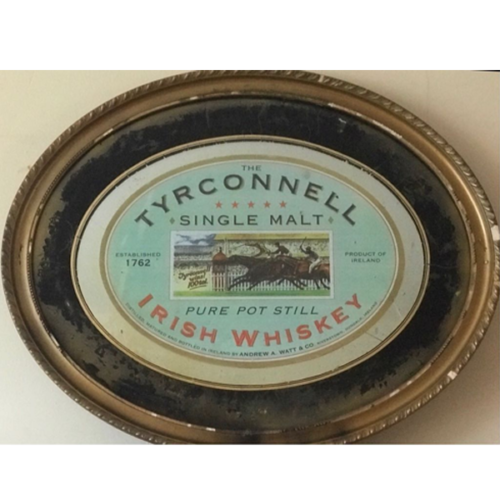 Classic,oval shaped Tyrconnell Whiskey Mirror,depicting the racehorse Tyrconnell (Gaelic for Co Donegal) who was owned by the Distillery's founder, the very wealthy Andrew Watt. This historic brand of whiskey has now been revived by the Cooley Distillery (which is now part of Beam Suntory).The brand was previously owned by the Watt Distillery, which (according to the company) dates back to 1762. The Tyrconnell was their flagship brand, and was named after a racehorse owned by Andrew Alexander Watt. The horse was a chestnut colt that won at 100 to 1 odds in 1876 in the Irish horse race called The National Produce Stakes.The actual horse race is depicted on the label. Tír Chonaill in the Irish Language comes from Tír meaning “Land of” and Chonaill which was the name of an ancient 5th Century High King of the North West of Ireland in the 5th century who was a son of the famous Niall of the Nine Hostages. Tyrconnell was therefore the name of this ancient North West Irish Kingdom and is still to this day used as the Irish language name of Donegal in the North West of Ireland. Tír Chonaill would have encompassed the modern county of Donegal and much of her neighbouring counties of Sligo, Leitrim, Fermanagh and Tyrone. The Kingdom survived until 1601. In 1876, the Donegal – Derry based Watt family who owned one of the largest whiskey distilleries in Ireland entered a racehorse called “Tyrconnell” (after the local ancient kingdom) in the Irish Classic “National Produce Stakes” where it won against all the odds at an incredible 100 to 1. This spectacular achievement inspired the Watt whiskey distillery in Derry to celebrate the occasion with a special commemorative Tyrconnell Irish whiskey label. The Tyrconnell was, before American prohibition, one of the biggest selling whiskey brands in the United States. Pre-prohibition photos taken in Yankee Stadium in New York show Tyrconnell Irish Whiskey billboards in positions of prominence at the venue. All three of the company’s whiskey brands enjoyed great success in the export sector. Sales in England, Canada, Australia, Nigeria and the West Indies and the U.S. put Derry on the commercial map as never before. Unfortunately, with the decline of Irish Whiskey after prohibition, Watts distillery and Tyrconnell whiskey faded and died like the majority of Irish whiskey distilleries and brands of the time. When the Cooley Irish Whiskey Distillery was recommissioned by Dr. John Teeling a few years ago, Tyrconnell was one of the old iconic Irish whiskey brands that Cooley brought back to life. Cooley Distillery and the Cooley Irish Whiskey brands are now owned by the Japanese – American whiskey giant Beam Suntory. Today, Tyrconnell whiskey is available as a standard 10 Year Old Cooley Single Malt and is also available through the Tyrconnell Irish Whiskey Finishes Collection in Port Pipe, Madeira Cask and Sherry Butt finishes at 46% abv as well as a 15 Year Old Single Cask expression. Andrew Watt (4 November 1853 – 11 October 1928) was an Anglo-Irish businessman with a net worth of over £900,000 at his death in 1928, worth £51.8 million in 2016.He was born in 1853 to Samuel Watt of Thornhill and his wife Jane Newman, daughter of Captain Robert Newman, R.N.. He was educated at Foyle College and then at home by tutors. His family were gentry who had arrived at Claragh in County Donegal during one of the Ulster Plantations.He was the owner of Watt's Distillery, one of the largest distilleries in Ireland, and the creator of many whiskies including the famous Tyrconnell,which he named after his racehorse that won the National Produce Stakes against the odds of 100 to 1. During industrial unrest of 1921, brought about by prohibition in the United States and the First World War, Watt's workers at the distillery were made redundant after challenging his authority. Watt is said to have stood on a barrel outside the gates to his distillery in Bogside, whilst the workers were on strike, and shouted, 'Well men, I shall put it to you like this …what is it to be? Will you open the gates?' To which the workers retorted, 'The gates stay shut!' This prompted Watt to reply, 'Shut they are, and shut they shall remain!' Watt subsequently closed down the distillery at great economic expense. On 7 October 1895, he married Violet Flora de Burgh, daughter of George de Burgh and Constance Matthews, with whom he had 4 sons and 2 daughters.He served as High Sheriff of County Londonderry from 1886 to 1887.He was a member of Boodle's. He died at Easton Hall, where he lived in England after he left Ireland. Below is an additional and very interesting article from the Derry Historical Journal chronicling the rise and fall, like so many other Irish Whiskey distilleries, of the once all conquering Watts "Tyrconnell" brand.
Classic,oval shaped Tyrconnell Whiskey Mirror,depicting the racehorse Tyrconnell (Gaelic for Co Donegal) who was owned by the Distillery's founder, the very wealthy Andrew Watt. This historic brand of whiskey has now been revived by the Cooley Distillery (which is now part of Beam Suntory).The brand was previously owned by the Watt Distillery, which (according to the company) dates back to 1762. The Tyrconnell was their flagship brand, and was named after a racehorse owned by Andrew Alexander Watt. The horse was a chestnut colt that won at 100 to 1 odds in 1876 in the Irish horse race called The National Produce Stakes.The actual horse race is depicted on the label. Tír Chonaill in the Irish Language comes from Tír meaning “Land of” and Chonaill which was the name of an ancient 5th Century High King of the North West of Ireland in the 5th century who was a son of the famous Niall of the Nine Hostages. Tyrconnell was therefore the name of this ancient North West Irish Kingdom and is still to this day used as the Irish language name of Donegal in the North West of Ireland. Tír Chonaill would have encompassed the modern county of Donegal and much of her neighbouring counties of Sligo, Leitrim, Fermanagh and Tyrone. The Kingdom survived until 1601. In 1876, the Donegal – Derry based Watt family who owned one of the largest whiskey distilleries in Ireland entered a racehorse called “Tyrconnell” (after the local ancient kingdom) in the Irish Classic “National Produce Stakes” where it won against all the odds at an incredible 100 to 1. This spectacular achievement inspired the Watt whiskey distillery in Derry to celebrate the occasion with a special commemorative Tyrconnell Irish whiskey label. The Tyrconnell was, before American prohibition, one of the biggest selling whiskey brands in the United States. Pre-prohibition photos taken in Yankee Stadium in New York show Tyrconnell Irish Whiskey billboards in positions of prominence at the venue. All three of the company’s whiskey brands enjoyed great success in the export sector. Sales in England, Canada, Australia, Nigeria and the West Indies and the U.S. put Derry on the commercial map as never before. Unfortunately, with the decline of Irish Whiskey after prohibition, Watts distillery and Tyrconnell whiskey faded and died like the majority of Irish whiskey distilleries and brands of the time. When the Cooley Irish Whiskey Distillery was recommissioned by Dr. John Teeling a few years ago, Tyrconnell was one of the old iconic Irish whiskey brands that Cooley brought back to life. Cooley Distillery and the Cooley Irish Whiskey brands are now owned by the Japanese – American whiskey giant Beam Suntory. Today, Tyrconnell whiskey is available as a standard 10 Year Old Cooley Single Malt and is also available through the Tyrconnell Irish Whiskey Finishes Collection in Port Pipe, Madeira Cask and Sherry Butt finishes at 46% abv as well as a 15 Year Old Single Cask expression. Andrew Watt (4 November 1853 – 11 October 1928) was an Anglo-Irish businessman with a net worth of over £900,000 at his death in 1928, worth £51.8 million in 2016.He was born in 1853 to Samuel Watt of Thornhill and his wife Jane Newman, daughter of Captain Robert Newman, R.N.. He was educated at Foyle College and then at home by tutors. His family were gentry who had arrived at Claragh in County Donegal during one of the Ulster Plantations.He was the owner of Watt's Distillery, one of the largest distilleries in Ireland, and the creator of many whiskies including the famous Tyrconnell,which he named after his racehorse that won the National Produce Stakes against the odds of 100 to 1. During industrial unrest of 1921, brought about by prohibition in the United States and the First World War, Watt's workers at the distillery were made redundant after challenging his authority. Watt is said to have stood on a barrel outside the gates to his distillery in Bogside, whilst the workers were on strike, and shouted, 'Well men, I shall put it to you like this …what is it to be? Will you open the gates?' To which the workers retorted, 'The gates stay shut!' This prompted Watt to reply, 'Shut they are, and shut they shall remain!' Watt subsequently closed down the distillery at great economic expense. On 7 October 1895, he married Violet Flora de Burgh, daughter of George de Burgh and Constance Matthews, with whom he had 4 sons and 2 daughters.He served as High Sheriff of County Londonderry from 1886 to 1887.He was a member of Boodle's. He died at Easton Hall, where he lived in England after he left Ireland. Below is an additional and very interesting article from the Derry Historical Journal chronicling the rise and fall, like so many other Irish Whiskey distilleries, of the once all conquering Watts "Tyrconnell" brand.When Bogside whiskey was the toast of the world
 By 1887 Watts Distillery at Abbey Street was the largest in Ireland and had become a world leader in whiskey production. The massive city centre plant covered eight acres, which included Abbey Street, Fahan Street and adjoining thoroughfares.
By 1887 Watts Distillery at Abbey Street was the largest in Ireland and had become a world leader in whiskey production. The massive city centre plant covered eight acres, which included Abbey Street, Fahan Street and adjoining thoroughfares. At that time the company’s director, David Watt, installed a second Coffey still - an invention by Aeneas Coffey which revolutionised the whiskey industry - to boost output to an incredible two million gallons a year.The firm developed three major brands, Tyrconnell, Favourite and Innishowen. In 1876, Andrew Alexander Watt entered a racehorse called “Tyrconnell” in the Irish Classic ‘National Produce Stakes’ and it won against all the odds at an incredible 100 to 1. This spectacular achievement inspired the Watt distillery to celebrate the occasion with a special commemorative Tyrconnell label. The Tyrconnell was, before prohibition, one of the biggest selling whiskey brands in the United States. Pre-prohibition photos of Yankee Stadium in New York show Tyrconnell billboards in positions of prominence at the venue. All three of the company’s brand names enjoyed great success in the export sector. Sales in England, Canada, Australia, Nigeria and the West Indies and the US put Derry on the commercial map as never before. Water used in the distillery came from the surrounding Derry hills and was stored in reservoirs on site. The wheat and maize stores were immense. At any one time, the warehouses, ranging in size from two to four storeys in height, contained 2,000 tons of wheat and barley; 1,000 tons of maize; 1,600 tons of barley, oats and maize. Attached to these buildings were two large “Malakoff’ dry-corn kilns, capable of drying 30 tons of corn every 24 hours, while in each of the two malting houses, 16 tons of grain were malted in a steep (50 ft in length by 9 ft wide) four times a week. The Coffey stills - the revolutionary inventions designed by Aeneas Coffey - were located in a still house which was seven storeys high, the tallest building in the city apart from the Cathedral. After dilution and casking, the barrels were taken to one of the five warehouses by an overhead railway pulled by a small steam engine. An advantage by-product from the Coffey stills was fusel oil which was used to light the distillery. It had a distinctive all pervading spirituous smell that the men carried home with them in their clothes. The Abbey Street site had many distinctive features notably two massive chimneys, one 160 feet and the other 130 feet high.Around 1820, James Robinson started distilling in the Waterside with a simple 76-gallon still. The operation was later acquired by the Meehan family who built a street in the Waterside called Meehan’s Row to accommodate the distillery workers. By the early 1830’s, the Watt family purchased the business and set out on a planned, systematic expansion of the site. Despite being successful, the Waterside operation always laboured in the shadow of the Abbey street distillery. In the 1880s, Abbey Street had the capacity to produce two million gallons of whiskey a year; the Waterside’s maximum output was 200,000 gallons. It is possible that the geographical location inhibited major expansion as the premises were situated on a steep hill and were flanked by two major thoroughfares. The decision was taken in 1902-03 by the Watt family to merge with two Belfast distilleries, the small Avoniel, owned by William Higgins and the Irish Distillery Ltd., Connswater, to form the United Distilleries Company Limited (UDC). Andrew Watt would chair the new consortium that had the capability to produce the six million gallons of grain whiskey per year. The operation would have several Coffey stills and would exert great influence within the industry becoming a major supplier of grain whiskey to blenders in both Scotland and England. Things worked perfectly at first but around 1908 and 1910, conflict arose between the UDC group and Scottish giants DCL based in Edinburgh. A series of further complicated deals between them served only to undermine confidence in both organisations. This was to be the beginning of the end for the huge Derry operation and company head, Andrew Alexander Watt closed the business after the strike of 1921. Watt himself died at his English estate in Easton Hall near Grantham in October 1928 at the age of 75. Derry Auther Ken McCormick describes the last encounter of AA Watt with his employees in a wonderful account ‘The Folly of Andrew Watt’ in his book ‘Ken McCormick’s Derry - Heroes, Villains and Ghosts’.“A gleaming yellow Rolls Royce slowly making its way through the gloom of a cold foggy morning in the Bogside in the year 1921. The air is tense and there are huddles of men everywhere - unbelievably, the workers of Watt’s Distillery are on strike. The eight-acre site, normally humming with activity round the clock, is as silent as the grave. But in the approaching vehicle is 68 year - old Andrew Alexander Watt, and he’s intent on a showdown . . . “Andrew Watt asked to be helped up on to one of his own whiskey barrels and from there he addressed the crowd with the menacing words - ‘Well men, I shall put it to you like this . . . what is it to be? Will you open the gates?’ The workers retorted angrily- ‘The gates stay shut!’ ‘Very well!’ exclaimed Watt bluntly. ‘Shut they are, and shut they shall remain!’ “In that bleak instant the Watt’s whiskey enterprise disappeared from Derry forever. Over 300 jobs were lost, including the talents of some of Ireland’s finest whiskey blenders. Also left jobless were coopers, carpenters and a host of other tradesfolk and office staff, many of whose parents and grandparents had worked for Watts for generations.“As for A A Watt, he left the city never to return. In doing so he turned his back on what would be a multi-million pound business in today’s world. Looking back, the outcome can only be viewed as a total disaster.” It ranks as one of the bleakest days in Derry’s industrial history and marked the end the city’s reputation as a world leader in whiskey production. Mr McCormick adds: “The loss was staggering.” The tensions created by the War of Independents and the Civil War and the introduction of new laws demanding that grain whiskey be laid down for three years before it could be sold may have had a bearing on Watt’s decision to shut up shop, although many agree that it was his expansionist tendency’s which were as Mr McCormick put it “his folly”. “Quite simply he bit off more than he could chew and left his whole operation vulnerable to a take-over,” he adds. Meanwhile some people maintained that a fire - in which several employees died - at the Abbey St distillery in 1915 was the beginning of the end for the Watts. According to Mr McCormick: “The vats had to be opened and it seems whiskey flowed along the gutters - much to the delight of the locals, it must be said, for they were able to collect bucketfuls of the precious spirit!”
At that time the company’s director, David Watt, installed a second Coffey still - an invention by Aeneas Coffey which revolutionised the whiskey industry - to boost output to an incredible two million gallons a year.The firm developed three major brands, Tyrconnell, Favourite and Innishowen. In 1876, Andrew Alexander Watt entered a racehorse called “Tyrconnell” in the Irish Classic ‘National Produce Stakes’ and it won against all the odds at an incredible 100 to 1. This spectacular achievement inspired the Watt distillery to celebrate the occasion with a special commemorative Tyrconnell label. The Tyrconnell was, before prohibition, one of the biggest selling whiskey brands in the United States. Pre-prohibition photos of Yankee Stadium in New York show Tyrconnell billboards in positions of prominence at the venue. All three of the company’s brand names enjoyed great success in the export sector. Sales in England, Canada, Australia, Nigeria and the West Indies and the US put Derry on the commercial map as never before. Water used in the distillery came from the surrounding Derry hills and was stored in reservoirs on site. The wheat and maize stores were immense. At any one time, the warehouses, ranging in size from two to four storeys in height, contained 2,000 tons of wheat and barley; 1,000 tons of maize; 1,600 tons of barley, oats and maize. Attached to these buildings were two large “Malakoff’ dry-corn kilns, capable of drying 30 tons of corn every 24 hours, while in each of the two malting houses, 16 tons of grain were malted in a steep (50 ft in length by 9 ft wide) four times a week. The Coffey stills - the revolutionary inventions designed by Aeneas Coffey - were located in a still house which was seven storeys high, the tallest building in the city apart from the Cathedral. After dilution and casking, the barrels were taken to one of the five warehouses by an overhead railway pulled by a small steam engine. An advantage by-product from the Coffey stills was fusel oil which was used to light the distillery. It had a distinctive all pervading spirituous smell that the men carried home with them in their clothes. The Abbey Street site had many distinctive features notably two massive chimneys, one 160 feet and the other 130 feet high.Around 1820, James Robinson started distilling in the Waterside with a simple 76-gallon still. The operation was later acquired by the Meehan family who built a street in the Waterside called Meehan’s Row to accommodate the distillery workers. By the early 1830’s, the Watt family purchased the business and set out on a planned, systematic expansion of the site. Despite being successful, the Waterside operation always laboured in the shadow of the Abbey street distillery. In the 1880s, Abbey Street had the capacity to produce two million gallons of whiskey a year; the Waterside’s maximum output was 200,000 gallons. It is possible that the geographical location inhibited major expansion as the premises were situated on a steep hill and were flanked by two major thoroughfares. The decision was taken in 1902-03 by the Watt family to merge with two Belfast distilleries, the small Avoniel, owned by William Higgins and the Irish Distillery Ltd., Connswater, to form the United Distilleries Company Limited (UDC). Andrew Watt would chair the new consortium that had the capability to produce the six million gallons of grain whiskey per year. The operation would have several Coffey stills and would exert great influence within the industry becoming a major supplier of grain whiskey to blenders in both Scotland and England. Things worked perfectly at first but around 1908 and 1910, conflict arose between the UDC group and Scottish giants DCL based in Edinburgh. A series of further complicated deals between them served only to undermine confidence in both organisations. This was to be the beginning of the end for the huge Derry operation and company head, Andrew Alexander Watt closed the business after the strike of 1921. Watt himself died at his English estate in Easton Hall near Grantham in October 1928 at the age of 75. Derry Auther Ken McCormick describes the last encounter of AA Watt with his employees in a wonderful account ‘The Folly of Andrew Watt’ in his book ‘Ken McCormick’s Derry - Heroes, Villains and Ghosts’.“A gleaming yellow Rolls Royce slowly making its way through the gloom of a cold foggy morning in the Bogside in the year 1921. The air is tense and there are huddles of men everywhere - unbelievably, the workers of Watt’s Distillery are on strike. The eight-acre site, normally humming with activity round the clock, is as silent as the grave. But in the approaching vehicle is 68 year - old Andrew Alexander Watt, and he’s intent on a showdown . . . “Andrew Watt asked to be helped up on to one of his own whiskey barrels and from there he addressed the crowd with the menacing words - ‘Well men, I shall put it to you like this . . . what is it to be? Will you open the gates?’ The workers retorted angrily- ‘The gates stay shut!’ ‘Very well!’ exclaimed Watt bluntly. ‘Shut they are, and shut they shall remain!’ “In that bleak instant the Watt’s whiskey enterprise disappeared from Derry forever. Over 300 jobs were lost, including the talents of some of Ireland’s finest whiskey blenders. Also left jobless were coopers, carpenters and a host of other tradesfolk and office staff, many of whose parents and grandparents had worked for Watts for generations.“As for A A Watt, he left the city never to return. In doing so he turned his back on what would be a multi-million pound business in today’s world. Looking back, the outcome can only be viewed as a total disaster.” It ranks as one of the bleakest days in Derry’s industrial history and marked the end the city’s reputation as a world leader in whiskey production. Mr McCormick adds: “The loss was staggering.” The tensions created by the War of Independents and the Civil War and the introduction of new laws demanding that grain whiskey be laid down for three years before it could be sold may have had a bearing on Watt’s decision to shut up shop, although many agree that it was his expansionist tendency’s which were as Mr McCormick put it “his folly”. “Quite simply he bit off more than he could chew and left his whole operation vulnerable to a take-over,” he adds. Meanwhile some people maintained that a fire - in which several employees died - at the Abbey St distillery in 1915 was the beginning of the end for the Watts. According to Mr McCormick: “The vats had to be opened and it seems whiskey flowed along the gutters - much to the delight of the locals, it must be said, for they were able to collect bucketfuls of the precious spirit!”Origins : Co Louth Dimensions :64x56cm 10 kg -
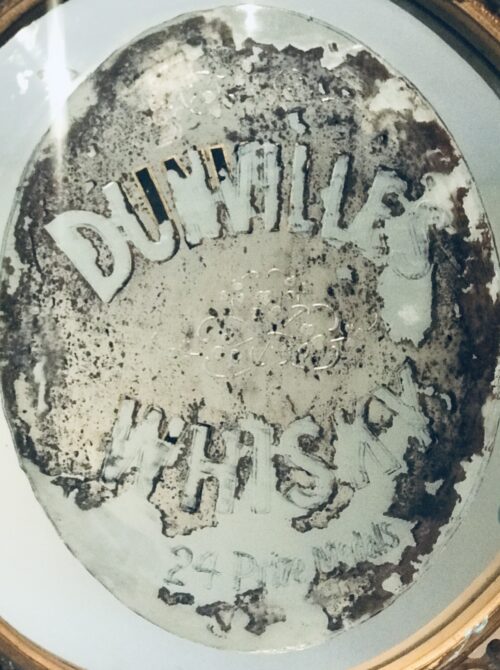
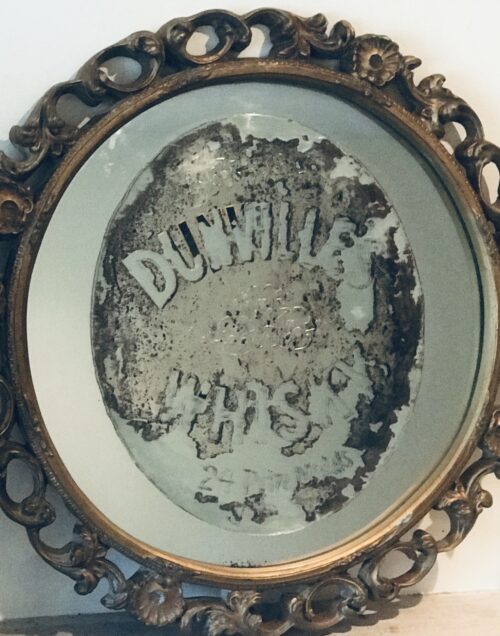 Absolutely stunning Dunvilles mirror, estimated to date from the 1880s.Although the paintwork is somewhat worn, this mirror is a real collectors item and has been mounted on a larger oval shaped mirror with a gilded frame to accentuate the beauty of the original piece. 55cm x 50cm Dunville & Co. was a tea and spirits merchant company, based in Belfast, County Antrim. The company initially gained success as an Irish whiskey blender, but later produced and marketed its own whiskey, having constructed its own distillery. The company was founded by John Dumvill who joined William Napier of Napier & Co. The spelling of Dumvill was changed to Dunville and in 1825 the company name became Dunville & Co. In 1837, Dunville began producing its most popular whisky Dunville's VR. Dunville's was the main brand name of Dunville & Co, and was used in advertisements, on pub windows and pub mirrors such as the beautiful example featured here on the irishpubemporium.com and on whisky dispensers, water jugs, trays, match strikers, ash trays and playing cards.Although Dunville & Co was established and based in Ireland, before the Partition of Ireland, and Irish whiskey is normally spelt with an 'e' in 'whiskey', Dunville's Whisky was always spelt without an 'e' in 'Whisky'.In 2013, almost 80 years after the last Dunville's was distilled, the Echlinville Distillery revived the Dunville's brand, and began distilling at their facility in the Ards Peninsula. Previously they had purchased spirits from other distillers and aged it themselves. Dunville's VR Old Irish Whiskey and Dunville's Three Crowns Irish Whiskey from The Echlinville Distillery came on the market in 2016. Having gained success as a whiskey blender, Dunville & Co. constructed their own distillery, the Royal Irish Distilleries, on the edge of Belfast in 1869. When built, the distillery occupied an impressive four-storey red-brick building, and was amongst the most modern in Ireland.With production from five pot stills, and later a Coffey still, at its peak the distillery had a capacity of over 2.5 million gallons per annum, making it amongst the largest in the country.Much of the distillery's output was used in the company's whiskey blends, Dunville's VR and Dunville's Three Crowns. Although, like other Irish distilleries, Prohibition caused Dunville to lose access to the important American market, Dunville ended the 1920s in good financial health. However, when the last heir and chairman of Dunville, Robert Lambart Dunville, died in 1931, the company began to flounder, and left to its directors, in 1936 Dunville & Co. was liquidated. Incredibly, and almost uniquely amongst the Irish distilleries that closed in the 20th century, liquidation was not forced upon the firm, as Dunville was actually still profitable when it was wound up.The main brand name of Dunville & Co. was used in advertisements, on pub windows and pub mirrors, and on whisky dispensers, water jugs, trays, match strikers, ash trays and playing cards. Although Dunville & Co was established and based in Ireland, before the Partition of Ireland, and Irish whiskey is normally spelt with an 'e' in 'whiskey', Dunville's Whisky was always spelt without an 'e' in 'Whisky'. In 2013, almost 80 years after the last Dunville's was distilled, the Echlinville Distillery revived the Dunville's brand, and began distilling at their facility in the Ards Peninsula. Previously they had purchased spirits from other distillers and aged it themselves. Dunville's VR Old Irish Whiskey and Dunville's Three Crowns Irish Whiskey from The Echlinville Distillery came on the market in 2016.
Absolutely stunning Dunvilles mirror, estimated to date from the 1880s.Although the paintwork is somewhat worn, this mirror is a real collectors item and has been mounted on a larger oval shaped mirror with a gilded frame to accentuate the beauty of the original piece. 55cm x 50cm Dunville & Co. was a tea and spirits merchant company, based in Belfast, County Antrim. The company initially gained success as an Irish whiskey blender, but later produced and marketed its own whiskey, having constructed its own distillery. The company was founded by John Dumvill who joined William Napier of Napier & Co. The spelling of Dumvill was changed to Dunville and in 1825 the company name became Dunville & Co. In 1837, Dunville began producing its most popular whisky Dunville's VR. Dunville's was the main brand name of Dunville & Co, and was used in advertisements, on pub windows and pub mirrors such as the beautiful example featured here on the irishpubemporium.com and on whisky dispensers, water jugs, trays, match strikers, ash trays and playing cards.Although Dunville & Co was established and based in Ireland, before the Partition of Ireland, and Irish whiskey is normally spelt with an 'e' in 'whiskey', Dunville's Whisky was always spelt without an 'e' in 'Whisky'.In 2013, almost 80 years after the last Dunville's was distilled, the Echlinville Distillery revived the Dunville's brand, and began distilling at their facility in the Ards Peninsula. Previously they had purchased spirits from other distillers and aged it themselves. Dunville's VR Old Irish Whiskey and Dunville's Three Crowns Irish Whiskey from The Echlinville Distillery came on the market in 2016. Having gained success as a whiskey blender, Dunville & Co. constructed their own distillery, the Royal Irish Distilleries, on the edge of Belfast in 1869. When built, the distillery occupied an impressive four-storey red-brick building, and was amongst the most modern in Ireland.With production from five pot stills, and later a Coffey still, at its peak the distillery had a capacity of over 2.5 million gallons per annum, making it amongst the largest in the country.Much of the distillery's output was used in the company's whiskey blends, Dunville's VR and Dunville's Three Crowns. Although, like other Irish distilleries, Prohibition caused Dunville to lose access to the important American market, Dunville ended the 1920s in good financial health. However, when the last heir and chairman of Dunville, Robert Lambart Dunville, died in 1931, the company began to flounder, and left to its directors, in 1936 Dunville & Co. was liquidated. Incredibly, and almost uniquely amongst the Irish distilleries that closed in the 20th century, liquidation was not forced upon the firm, as Dunville was actually still profitable when it was wound up.The main brand name of Dunville & Co. was used in advertisements, on pub windows and pub mirrors, and on whisky dispensers, water jugs, trays, match strikers, ash trays and playing cards. Although Dunville & Co was established and based in Ireland, before the Partition of Ireland, and Irish whiskey is normally spelt with an 'e' in 'whiskey', Dunville's Whisky was always spelt without an 'e' in 'Whisky'. In 2013, almost 80 years after the last Dunville's was distilled, the Echlinville Distillery revived the Dunville's brand, and began distilling at their facility in the Ards Peninsula. Previously they had purchased spirits from other distillers and aged it themselves. Dunville's VR Old Irish Whiskey and Dunville's Three Crowns Irish Whiskey from The Echlinville Distillery came on the market in 2016.







